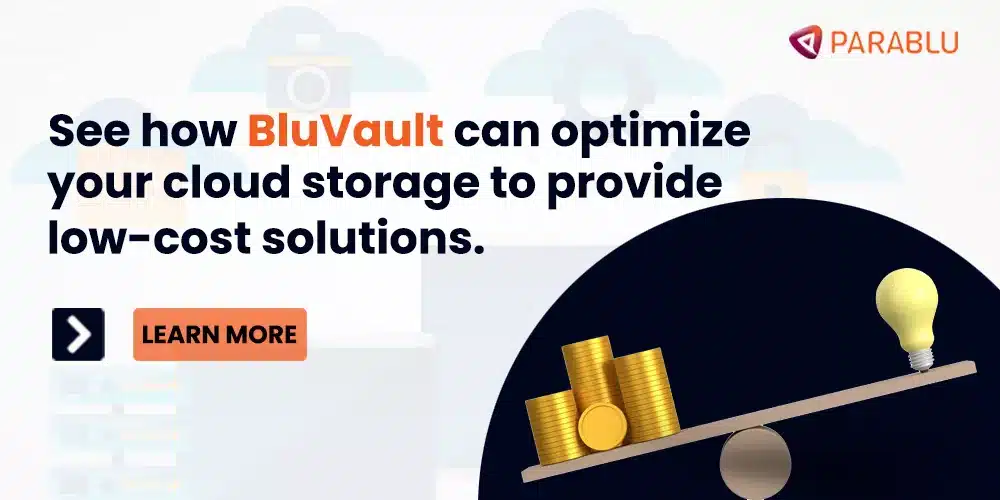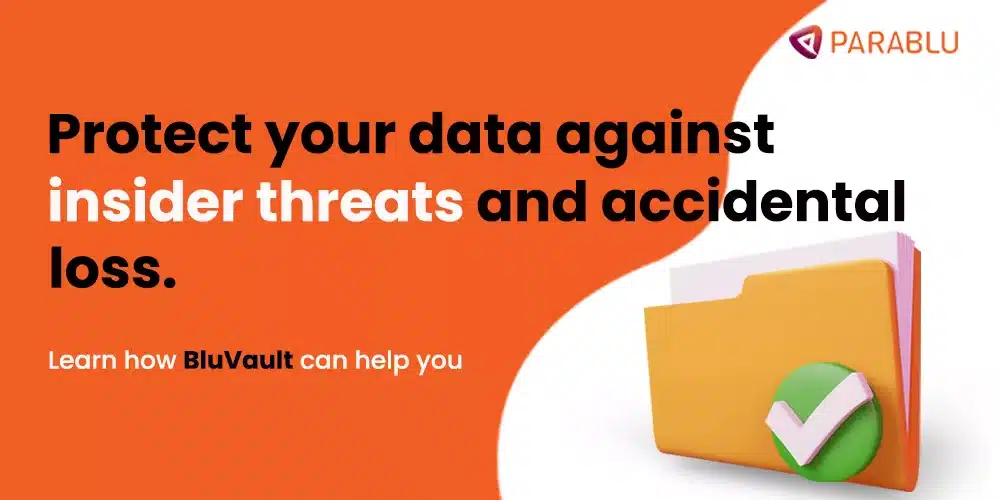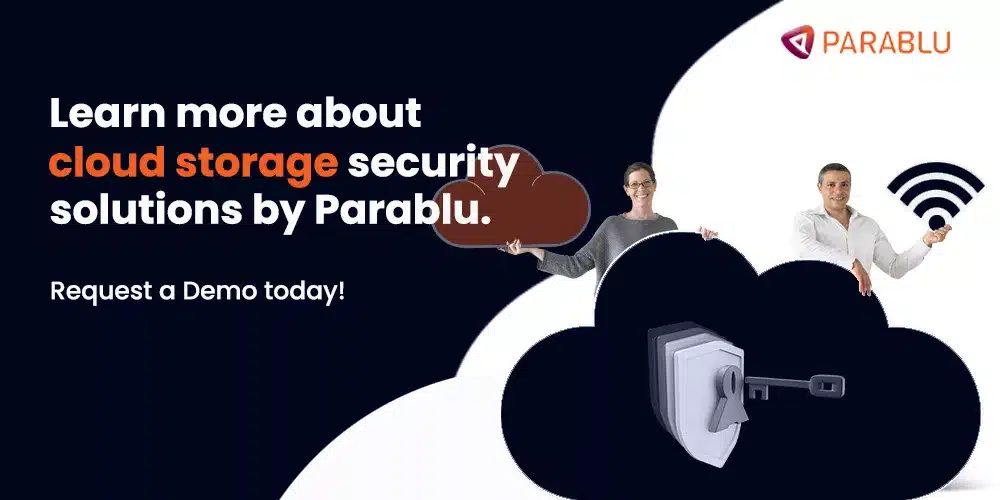Cloud Storage Solutions: Decoding the Cost Components

Hey there, cloud enthusiasts!
Ready to embark on a journey that will demystify the world of cloud data storage pricing?
Well, you are at the right place!
Cloud storage is now the go-to solution for organizations looking to streamline their data management. It offers flexibility, scalability, and accessibility. But here’s the thing: understanding the factors contributing to the cost components of cloud storage can be a real head-scratcher. It’s like trying to solve a puzzle without all the pieces.
So, I’m here to help you understand and decode the cost components.
At Parablu, we believe that knowledge is power. We’re here to equip you with the knowledge you need to make informed decisions about your cloud storage strategy. In this blog, we will break down the key factors determining the cost of storing your data in the cloud. By the end of this blog, you’ll have the insights and strategies to optimize costs and make the most of your cloud storage investment. And that’s a promise!
Understanding cloud storage and why your budget matters
Cloud storage is a virtual space where you can store and access your data over the internet. It’s like having a digital storage locker to access anytime, anywhere. The cost of cloud storage matters because it directly impacts your budget. Understanding the cost components allows you to optimize your storage choices and avoid unnecessary expenses. It’s all about finding the right balance between storage needs and cost-effectiveness. This ensures you get the most value from your cloud storage investment.
Cloud data storage is revolutionizing the way businesses store and manage their data. Understanding the key factors that drive this storage solution is crucial.
Storage capacity: How much is too much?
Storage capacity is a critical factor in cost-effective cloud data storage. As of 2020, the world’s digital data stood at a mind-boggling 44 zettabytes, projected to grow to 175 zettabytes by 2025. To strike the right balance, estimate your storage needs. Avoiding unnecessary costs is crucial. For instance, if your small business needs a 1-terabyte of storage, opting for a 2-terabyte plan would mean paying for excess capacity. At the same time, choosing a 500-gigabyte plan might lead to space constraints and unplanned expenses.
Assess your data requirements based on historical data. By finding the sweet spot, you’ll ensure cost-effectiveness without sacrificing storage needs. Remember, it’s about balancing your current needs while accounting for future growth.
So, take a closer look at your data, estimate your storage needs, and choose a plan that aligns with your requirements. Doing so will avoid the dreaded “too much” storage dilemma while keeping your costs in check.
Data transfer efficiency: Bridging the gap in cloud storage
Did you know transferring data to and from the cloud can impact your overall costs?
It’s true!
Cloud providers often charge for inbound and outbound data transfers. This covers activities like uploading, downloading, and accessing your data. These charges can add up, especially if you transfer large amounts of data. You could pay a hefty fee if you move around 1 terabyte of data. That’s why choosing a cloud service with cost-effective transfer policies is crucial. By optimizing cloud storage expenses, you can save a significant amount of money.
So, next time you consider a cloud provider, don’t forget to factor in the data transfer cost!
Hidden costs: Transaction fees in the cloud storage
When it comes to cloud services, even the most negligible costs can make a difference. One such cost component that often goes unnoticed is transaction fees.
Did you know that every time your business applications interact with the cloud, they incur a small transaction fee?
Every time your business applications interact with the cloud, there’s a fee involved. It could be as simple as scanning your cloud storage, listing its contents, or copying data within the same cloud.
Yes, most cloud providers charge less than a dollar for 100,000 transactions per month. But these charges can accumulate if you don’t keep track. So, stay on top of these transaction costs and monitor them to avoid any surprises on your bill.
Cloud storage sorted: Managing your data with ease!
Neglecting data management can lead to unexpected costs and strain your IT budget.
Data management is like keeping your cloud-based data organized and accessible. It helps you get, process, and store data efficiently in the cloud. Several studies estimate that by 2025, over 95% of new digital workloads will be deployed on cloud-native platforms. This is up from 30% in 2021.
To avoid accidental data loss, maintain track of your data. Stay organized so you can find it when you need it. Data management strategies also monitor your data to ensure everything is safe, flagging suspicious activity. If you don’t manage your data, it can mess up your IT budget. So, taking care of your data to make smart decisions and avoid unexpected costs is crucial.
Ensuring data security in cloud storage
We all know how valuable our data is, right? Data security in the cloud is an absolute must these days. Additionally, managing access to this data is pivotal. So, make sure you choose proper encryption solutions.
The price of protection: How data backup impacts cloud storage cost
Now, let’s talk about the unsung hero of cloud computing: data backup!
It’s like having a safety net for your critical information in case a disaster strikes. You’d want to feel free knowing your data is safe.
But, hey, there’s a catch!
This fabulous service is not free! It comes with a price tag. You’ll deal with extra costs when you back up your data on the cloud. On top of that, you must pay for backup software, data migration, and maintenance.
So, while designing your cloud strategy, remember to include this essential cost component.
Streamlining cloud storage: Costs and considerations of data migration
Moving your data to the cloud requires careful consideration. The cost of switching providers can be significant. It involves costs beyond service subscriptions, such as:
- Egress fees for retrieving data from the cloud provider’s storage.
- Data transfer expenses if your network has limited bandwidth.
- Potential data loss or corruption during the migration process.
- Reconfiguring applications and systems for compatibility with the new cloud environment.
- Ongoing maintenance and support costs with the new cloud provider.
- Data validation and testing to ensure integrity and accuracy after migration.
- Regulatory compliance and legal considerations during data transfer.
- Careful planning and thorough analysis are crucial to mitigate migration-related costs.
And many more.
Cloud storage classes: Picking the right option for your data
Think of storage classes as different types of storage options in the cloud. They come with varied features, costs, and performance levels.
You may have stored different documents, photos, videos, etc., in your cloud. Now, you need quick access to some of these files — like your monthly reports. And then you have files you don’t need to access as frequently, like old budget reports. That’s where cheaper options like infrequent access or cold storage come in handy.
So, by picking the correct storage class, you save money based on how often you need to access your stuff.
Understanding cloud data storage pricing is crucial for cost-effective solutions. Factors like storage capacity, data transfer efficiency, and more impact cost components. You can optimize your cloud storage strategy by estimating needs, optimizing cloud storage expenses, ensuring security, and leveraging lifecycle options.
Now it’s time to apply what you’ve learned and embark on a path toward optimized cloud data storage. Empower yourself, maximize your resources, and achieve cost-effective solutions. The cloud is yours to conquer!
Read more:
How different customers benefited from our offerings and solutions?
Cloud storage cost: An easy way to achieve zero cost storage for backup
5 Hidden costs to watch for when implementing a Backup Solution
How to make The Public Cloud Feel Private
Cloud backup and the importance of dual copy



